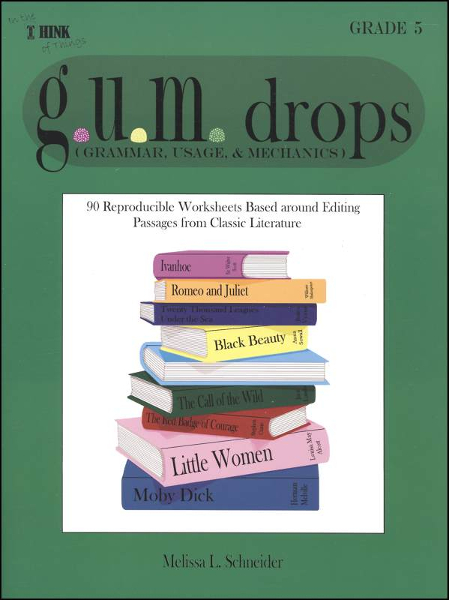g.u.m. drops (Grammar, Usage, & Mechanics) teaches grammar to students in grades one through eight by combining traditional-style instruction and exercises. Exercises use passages adapted from classic literature for students to mark up or edit.
One course book covers both grades one and two, while there are individual course books for grades three through eight. Each book has 90 student lesson pages plus answer key pages at the end that show reduced student pages with overprinted answers. You are given permission to copy student pages for one family or one classroom.
These courses are a lightweight approach to grammar. There’s no sentence analysis or diagramming, and a minimal amount of writing. Brief instruction on a topic such as adjectives, commas, homophones, and alphabetizing is followed by one exercise set to practice applying the concept. An exercise set might have from three to seven practice items.
While grammar, mechanics, and usage topics are often repeated from one level to the next, the presentation is generally more challenging at subsequent levels. For example, subject-verb agreement is taught at every level. The Grade 3 book teaches that if a subject of a sentence is singular, we generally add s to the end of the verb such as in “That girl runs fast.” It also explains that if the subject is plural, the s is not added as in “Those girls run fast.” It continues with a brief explanation of exceptions for the pronouns you and I. In Grade 7, it repeats the basic instruction then adds explanations for compound subjects connected by and plus compound subjects connected by or or nor.
After reading instructional material and practice activities, students apply the concept(s) they have learned as they mark up or edit a reading passage. If they have just learned about adjectives, the instructions for the reading passage might ask students to circle as many adjectives as they can find. As students progress, they are increasingly held accountable to catch capitalization, punctuation, and other errors. They are gradually given less specific instruction about what to look for, although the instructions might tell them that there are five things they need to find.
Every few lessons, there is an additional passage to edit titled Review Time!, and this provides cumulative practice for concepts taught in at least the last few lessons. Sometimes there are three or more reading-passage activities in a row with no instructional lessons. Each book includes a Midterm and a Final Examination in the form of yet another reading passage for editing and mark up. As you can see, most of the work a student does involves reading and editing passages.
The reading passages in the first three books are all from the Leveled Classic Readers series that used to be published by EDCON Publishing Group. These include age-appropriate adaptations of famous literary works such as The Merry Adventures of Robin Hood, The Call of the Wild, and The Prince and the Pauper. Brief excerpts from many books are used in these three courses. Excerpts were selected to present particular concepts students need to learn. This approach makes it possible to provide more sequential instruction which is needed for younger students.
The remaining four g.u.m. drops books use condensed retellings of six stories per course, stories such as The Secret Garden, Robinson Crusoe, and Around the World in 80 Days. Students work with the story segments in order so that they can grasp the main storyline of each novel. Although students are not exposed to the sentence structure and vocabulary of the original stories, they might find the storylines appealing enough to read the originals at a later time. Even though I might prefer books in their original forms, I understand g.u.m. drops intent to provide complete storylines as well as mark-up and editing activities that are carefully tailored to match up with instructional lessons. For those purposes, the adapted stories work best.
These courses should be relatively easy for average students, so a student might work a year or two beyond grade level if you wish. While you might use one of the lower-level books as your primary source of grammar instruction for grades one through four, g.u.m. drops should serve as supplements or review material for fifth grade and above. Younger students might need assistance to work through these courses, but older students should be able to work independently. Either way, lessons should not take much time to complete, leaving plenty of time for other language arts activities.
















